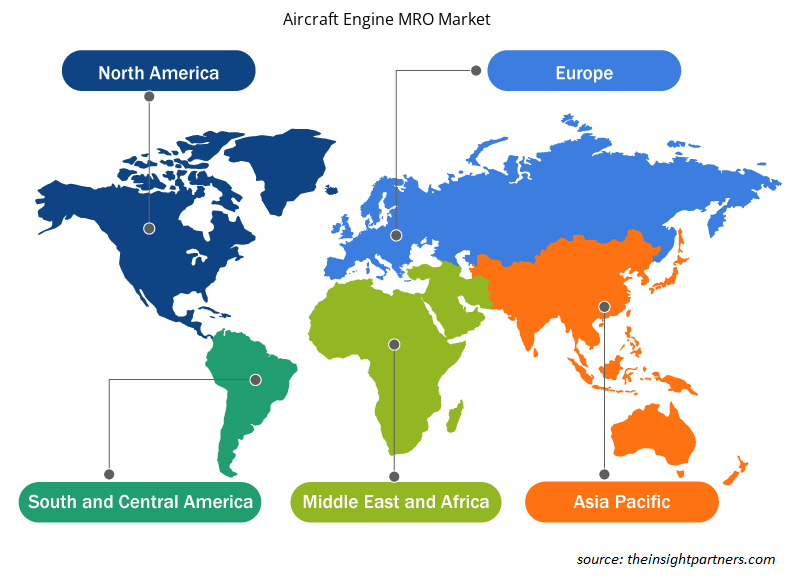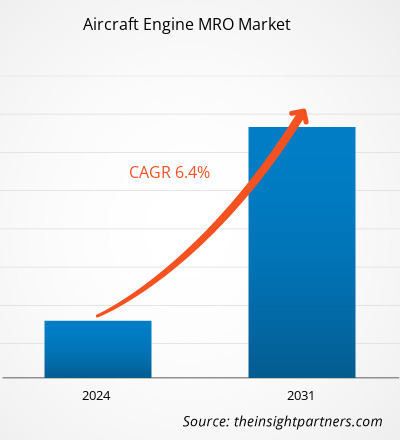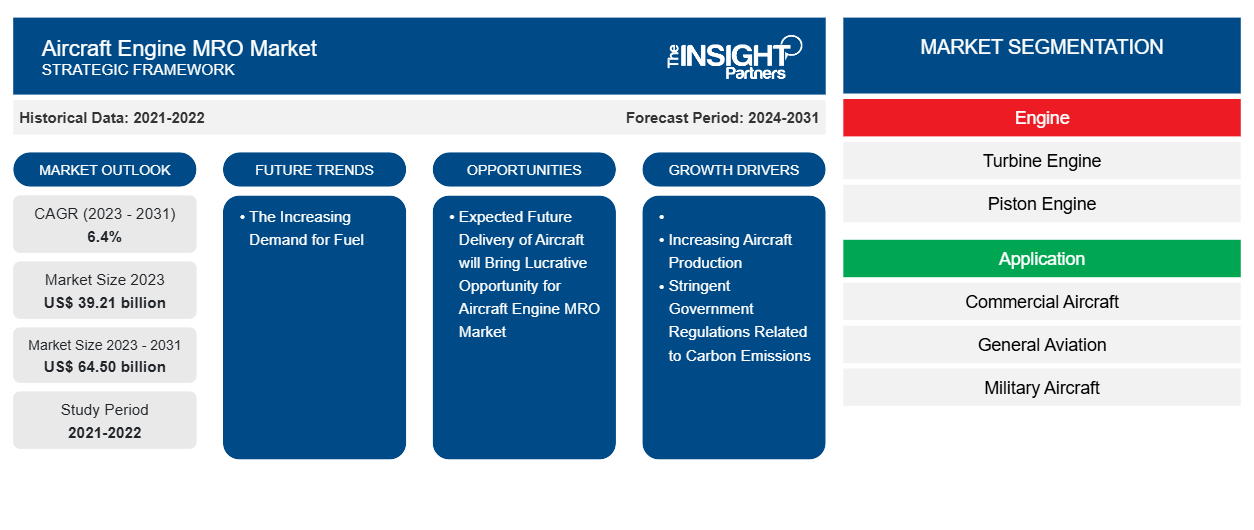Der Markt für Flugzeugtriebwerk-MRO wird voraussichtlich von 39,21 Milliarden US-Dollar im Jahr 2023 auf 64,50 Milliarden US-Dollar im Jahr 2031 anwachsen. Der Markt wird voraussichtlich zwischen 2023 und 2031 eine durchschnittliche jährliche Wachstumsrate von 6,4 % verzeichnen. Die steigende Nachfrage nach treibstoffeffizienten Flugzeugen dürfte ein wichtiger Trend auf dem MRO-Markt für Flugzeugtriebwerke bleiben.
Marktanalyse für die Wartung und Instandhaltung von Flugzeugtriebwerken
Flughäfen weltweit verfügen über verschiedene Arten von MRO-Einrichtungen für Triebwerke. Normalerweise wird die Wartung an der Flugzeugzelle oder am Triebwerk durchgeführt. Triebwerk-MRO-Dienste umfassen heutzutage auch die MRO von Komponenten. Je nach Art des Dienstes werden diese Dienste am Flughafen und manchmal auch in Einrichtungen außerhalb des Flughafens angeboten. Aktivitäten wie Routineinspektionen, regelmäßige Fehlerbehebung oder tägliche Triebwerksprüfungen können durchgeführt werden, wenn das Flugzeug im Flughafenterminal geparkt ist.
Marktübersicht für die Wartung und Instandhaltung von Flugzeugtriebwerken
Eine der wichtigsten Anwendungen der Wartung von Flugzeugtriebwerken besteht darin, sicherzustellen, dass alle rotierenden Teile des Triebwerks ausgewuchtet sind und die Vibrationen auf ein Minimum beschränkt bleiben. Dies verbessert die Haltbarkeit und Kraftstoffeffizienz des Triebwerks und begrenzt den vibrationsbedingten Motorverschleiß. Durch die Modernisierung von Flugzeugtriebwerken und zugehörigen Komponenten steigt auch der Bedarf an moderner Infrastruktur und qualifizierten Arbeitskräften für die Wartung von Flugzeugtriebwerken. Der Wartungsbedarf von Triebwerken variiert je nach Triebwerkstyp und -kategorie. Bei älteren und kleineren Flugzeugtriebwerken beträgt die Zeit zwischen den Überholungen (TBOs) maximal 5.000 Stunden. Moderne Triebwerke haben mehr als 6.000 Stunden TBOs. Da immer mehr Geschäftsflugzeuge weniger als 500 Stunden pro Jahr fliegen, beträgt der Wartungsbedarf der Triebwerke durchschnittlich 12 Jahre oder mehr.
Passen Sie diesen Bericht Ihren Anforderungen an
Sie erhalten kostenlos individuelle Anpassungen an jedem Bericht, einschließlich Teilen dieses Berichts oder einer Analyse auf Länderebene, eines Excel-Datenpakets sowie tolle Angebote und Rabatte für Start-ups und Universitäten.
-
Holen Sie sich die wichtigsten Markttrends aus diesem Bericht.Dieses KOSTENLOSE Beispiel umfasst eine Datenanalyse von Markttrends bis hin zu Schätzungen und Prognosen.
Treiber und Chancen auf dem MRO-Markt für Flugzeugtriebwerke
Strenge staatliche Vorschriften in Bezug auf Kohlenstoffemissionen
Im Jahr 2021 verkündete die US-Regierung ihr Ziel, die Flugzeugemissionen bis 2030 um 20 % zu senken. Mehrere Regulierungsbehörden setzen Strategien zur Reduzierung der CO2-Emissionen um. So schätzte die International Air Transport Association (IATA) im März 2022, dass bis 2050 mehr als 10 Milliarden Reisen pro Jahr mit dem Flugzeug unternommen werden würden , und kündigte daher an, bis 2050 Netto-Null-CO2-Emissionen zu erreichen.
Mehr als 60 % der Länder weltweit haben angekündigt, ihre CO2-Emissionen auf null zu senken. Unternehmen wie Honeywell Aerospace haben sich ebenfalls dazu verpflichtet, bis 2035 CO2-Emissionen auf null zu senken. Im November 2021 gab Bell Textron Inc. bekannt, dass die Bell 525 ihren ersten Flug mit nachhaltigem Flugkraftstoff absolviert hat. Boeing und Airbus haben kürzlich angekündigt, dass ihre Flugzeuge bis 2030 zu 100 % mit nachhaltigem Flugkraftstoff fliegen werden. Die US-amerikanische und die europäische Regierung werden ermutigt, nachhaltige Kraftstoffe zu produzieren. Diese Faktoren treiben den MRO-Markt für Flugzeugtriebwerke erheblich voran.Textron Inc. announced that Bell 525 completed its first flight utilizing sustainable aviation fuel. Boeing and Airbus have recently announced that by 2030, their aircraft will fly 100% on SAF. The US and European governments are encouraged to produce SAFs. These factors are propelling the aircraft engine MRO market substantially.
Erwartete zukünftige Auslieferungen von Verkehrsflugzeugen – eine Chance auf dem MRO-Markt für Flugzeugtriebwerke
Mit der Zunahme des Flugverkehrs und der Flugzeugnachfrage steigern die Fluggesellschaften ihre Flugzeugauslieferungen. Die Nachfrage nach neuen Fluggesellschaften kommt nicht nur von bestehenden Flugzeugen, die ihre Flotten erneuern, sondern auch von neuen Billigflugzeugen, die auf den Markt kommen. Das unterdrückte Interesse von Urlaubsreisenden, die nach der Pandemie kostenbewusster sind, das geringere Interesse an Geschäftsreisen und die Anpassungsfähigkeit des Aktionsplans für kostengünstige Flugzeuge lassen die Nachfrage nach MRO-Dienstleistungen steigen. Darüber hinaus werden laut den Prognosen von Boeing und Airbus bis Ende 2042 voraussichtlich mehr als 40.800 Verkehrsflugzeuge ausgeliefert, was den Einsatz neuer Triebwerke in der Flugzeugproduktion weiter vorantreibt. Dies wird die gesamte Flugzeugflotte weltweit weiter vergrößern und in den kommenden Jahren die Nachfrage nach Triebwerks-MRO sowie Marktanbietern steigern.
Segmentierungsanalyse des MRO-Marktberichts für Flugzeugtriebwerke
Wichtige Segmente, die zur Ableitung der MRO-Marktanalyse für Flugzeugtriebwerke beigetragen haben, sind Motor, Anwendung und Flugzeugtyp.
Motor [Turbinenmotor (Turboprop-Motor, Turbofan-Motor, Wellenleistungsmotor), Kolbenmotor], Anwendung (Verkehrsflugzeuge, allgemeine Luftfahrt, Militärflugzeuge), Flugzeugtyp (Starrflügel, Drehflügler)
- Basierend auf dem Motor ist der MRO-Markt für Flugzeugtriebwerke in Turbinentriebwerke und Kolbenmotoren unterteilt. Außerdem wurden Turbinentriebwerke weiter in Turboprop-Triebwerke, Turbofan-Triebwerke und Wellenleistungstriebwerke unterteilt. Das Segment der Turbinentriebwerke hatte im Jahr 2023 einen größeren Marktanteil.
- Basierend auf der Anwendung ist der Markt in Verkehrsflugzeuge, allgemeine Luftfahrt und Militärflugzeuge segmentiert. Das Segment der Verkehrsflugzeuge hatte im Jahr 2023 einen größeren Marktanteil.
- Basierend auf dem Flugzeugtyp ist der Markt in Starrflügel- und Drehflügelflugzeuge segmentiert. Das Starrflügelsegment hatte im Jahr 2023 einen größeren Marktanteil.
Marktanteilsanalyse für die Wartung und Instandhaltung von Flugzeugtriebwerken nach geografischen Gesichtspunkten
Der geografische Umfang des Marktberichts zur Wartung und Instandhaltung von Flugzeugtriebwerken ist hauptsächlich in fünf Regionen unterteilt: Nordamerika, Asien-Pazifik, Europa, Naher Osten und Afrika sowie Südamerika.
Im Jahr 2023 hatte der asiatisch-pazifische Raum einen großen Anteil am weltweiten MRO-Markt für Flugzeugtriebwerke, gefolgt von Nordamerika und Europa. Asiens Wirtschaft wird durch ein breites Spektrum an Einkommensniveaus und eine schnell wachsende Mittelschicht angetrieben. Dies führte zu starkem Umsatzwachstum in den schnell wachsenden Volkswirtschaften der Region, wie Indien und China. Es wird prognostiziert, dass der asiatisch-pazifische Raum der Markt mit den besten Aussichten für MRO-Dienstleister für Flugzeuge ist. Die Region umfasst mehrere Entwicklungsländer, die in einer Reihe von Branchen führend sind, wie z. B. Luft- und Raumfahrt, Militär & Verteidigung sowie Technologie. Viele wachsende Volkswirtschaften in der asiatisch-pazifischen Region streben nach regulatorischen Investitionen, um ihre Technologien zu verbessern. Dies würde letztendlich die Entwicklung und Nutzung neuer Technologien für die Flugzeugintegration ankurbeln . Mehrere Fluggesellschaften in der asiatisch-pazifischen Region, wie Singapore Airlines und Malaysian Airlines, bauen ihre internen Wartungskapazitäten aus. Pratt & Whitney, ein US-amerikanisches Luft- und Raumfahrtunternehmen, hat 2019 in seinem Eagle Services Asia-Werk in Singapur die MRO-Kapazitäten für sein Getriebefan-Triebwerk PW100G-JM erweitert. Im Laufe der Jahre hat dieses Werk Pratt & Whitney GTF-Triebwerke überholt. Mit der Einführung des Triebwerks PW100G-JM wird erwartet, dass die Anlage einen deutlichen Umsatzanstieg bei verschiedenen Flugzeugbetreibern verzeichnet, die das PW100G-JM verwenden. Darüber hinaus zählen der zunehmende Einsatz von Nachrüsttechnologien für verbesserte Flugzeuge und die zunehmende Einführung der Blockchain-Technologie zu den Hauptfaktoren, die das Wachstum des MRO-Marktes für Flugzeugtriebwerke vorantreiben. Das Wachstum des Marktes im asiatisch-pazifischen Raum ist außerdem auf die wachsende Flugzeugflotte aufgrund des steigenden Passagierverkehrs, die steigenden Ausgaben für Militärflugzeuge aufgrund des wachsenden Verteidigungsbudgets und die laufenden Projekte zur Entwicklung von Verkehrs-, allgemeinen und Militärflugzeugen zurückzuführen.
Regionale Einblicke in den MRO-Markt für Flugzeugtriebwerke
Die regionalen Trends und Faktoren, die den MRO-Markt für Flugzeugtriebwerke im Prognosezeitraum beeinflussen, wurden von den Analysten von Insight Partners ausführlich erläutert. In diesem Abschnitt werden auch die Marktsegmente und die Geografie für MRO-Flugzeugtriebwerke in Nordamerika, Europa, im asiatisch-pazifischen Raum, im Nahen Osten und Afrika sowie in Süd- und Mittelamerika erörtert.

- Erhalten Sie regionale Daten zum MRO-Markt für Flugzeugtriebwerke
Umfang des MRO-Marktberichts für Flugzeugtriebwerke
| Berichtsattribut | Details |
|---|---|
| Marktgröße im Jahr 2023 | 39,21 Milliarden US-Dollar |
| Marktgröße bis 2031 | 64,50 Milliarden US-Dollar |
| Globale CAGR (2023 - 2031) | 6,4 % |
| Historische Daten | 2021-2022 |
| Prognosezeitraum | 2024–2031 |
| Abgedeckte Segmente |
Nach Motor
|
| Abgedeckte Regionen und Länder |
Nordamerika
|
| Marktführer und wichtige Unternehmensprofile |
|
Marktteilnehmerdichte: Der Einfluss auf die Geschäftsdynamik
Der Markt für Flugzeugtriebwerke und deren Wartung wächst rasant. Dies wird durch die steigende Nachfrage der Endnutzer aufgrund von Faktoren wie sich entwickelnden Verbraucherpräferenzen, technologischen Fortschritten und einem größeren Bewusstsein für die Vorteile des Produkts vorangetrieben. Mit der steigenden Nachfrage erweitern Unternehmen ihr Angebot, entwickeln Innovationen, um die Bedürfnisse der Verbraucher zu erfüllen, und nutzen neue Trends, was das Marktwachstum weiter ankurbelt.
Die Marktteilnehmerdichte bezieht sich auf die Verteilung der Firmen oder Unternehmen, die in einem bestimmten Markt oder einer bestimmten Branche tätig sind. Sie gibt an, wie viele Wettbewerber (Marktteilnehmer) in einem bestimmten Marktraum im Verhältnis zu seiner Größe oder seinem gesamten Marktwert präsent sind.
Die wichtigsten auf dem MRO-Markt für Flugzeugtriebwerke tätigen Unternehmen sind:
- Delta Airlines, Inc.
- GE Aviation
- CFM International
- Lufthansa Technik
- MTU Aero Engines AG
- SIA Ingenieurgesellschaft
Haftungsausschluss : Die oben aufgeführten Unternehmen sind nicht in einer bestimmten Reihenfolge aufgeführt.

- Überblick über die wichtigsten Akteure auf dem MRO-Markt für Flugzeugtriebwerke
Neuigkeiten und aktuelle Entwicklungen zum MRO-Markt für Flugzeugtriebwerke
Der MRO-Markt für Flugzeugtriebwerke wird durch die Erhebung qualitativer und quantitativer Daten nach Primär- und Sekundärforschung bewertet, die wichtige Unternehmensveröffentlichungen, Verbandsdaten und Datenbanken umfasst. Im Folgenden finden Sie eine Liste der Entwicklungen auf dem Markt für Innovationen, Geschäftserweiterungen und Strategien:
- Im April 2024 unterzeichnete ITP Aero einen Vertrag mit dem kolumbianischen Verteidigungsministerium über die Wartung, Reparatur und Überholung (MRO) der T700-Triebwerke, die die Black Hawk-Hubschrauberflotte der Streitkräfte antreiben. Der Vertrag läuft bis Juni 2026 und die MRO-Leistungen für die Triebwerke werden in den Einrichtungen von ITP Aero in Albacete (Spanien) durchgeführt. (Quelle: ITP Aero, Pressemitteilung)
- Im November 2023 unterzeichnete die MTU Maintenance einen fünfjährigen Wartungs-, Reparatur- und Überholungsvertrag (MRO) für LEAP-1A mit SriLankan Airlines und baute damit auf der bestehenden Geschäftsbeziehung der beiden Unternehmen auf, die auch V2500-Triebwerke und Leasing-Support umfasst. Die nationale Fluggesellschaft Sri Lankas betreibt derzeit eine Flotte von 22 Airbus A330 und A320/A321 und führt Flüge in Südasien, Europa, dem Fernen Osten und dem Nahen Osten durch. (Quelle: MTU Maintenance, Newsletter)
Marktbericht zur Wartung und Instandhaltung von Flugzeugtriebwerken – Umfang und Ergebnisse
Der Bericht „Marktgröße und Prognose für die Wartung und Instandhaltung von Flugzeugtriebwerken (2021–2031)“ bietet eine detaillierte Analyse des Marktes, die die folgenden Bereiche abdeckt:
- Flugzeugtriebwerk-MRO-Marktgröße und -prognose auf globaler, regionaler und Länderebene für alle wichtigen Marktsegmente, die im Rahmen des Berichts abgedeckt sind
- Marktdynamik wie Treiber, Beschränkungen und wichtige Chancen
- MRO-Markttrends für Flugzeugtriebwerke
- Detaillierte Porters Fünf Kräfte
- MRO-Marktanalyse für Flugzeugtriebwerke, die wichtige Markttrends, globale und regionale Rahmenbedingungen, wichtige Akteure, Vorschriften und aktuelle Marktentwicklungen umfasst
- Branchenlandschaft und Wettbewerbsanalyse für die MRO von Flugzeugtriebwerken, einschließlich Marktkonzentration, Heatmap-Analyse, prominenten Akteuren und jüngsten Entwicklungen
- Detaillierte Firmenprofile
- Historische Analyse (2 Jahre), Basisjahr, Prognose (7 Jahre) mit CAGR
- PEST- und SWOT-Analyse
- Marktgröße Wert/Volumen – Global, Regional, Land
- Branchen- und Wettbewerbslandschaft
- Excel-Datensatz
Aktuelle Berichte
Erfahrungsberichte
Grund zum Kauf
- Fundierte Entscheidungsfindung
- Marktdynamik verstehen
- Wettbewerbsanalyse
- Kundeneinblicke
- Marktprognosen
- Risikominimierung
- Strategische Planung
- Investitionsbegründung
- Identifizierung neuer Märkte
- Verbesserung von Marketingstrategien
- Steigerung der Betriebseffizienz
- Anpassung an regulatorische Trends























 Kostenlose Probe anfordern für - MRO-Markt für Flugzeugtriebwerke
Kostenlose Probe anfordern für - MRO-Markt für Flugzeugtriebwerke